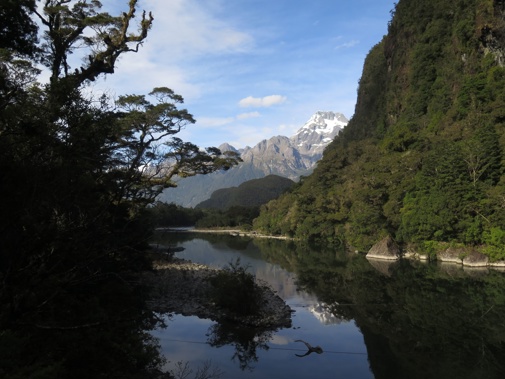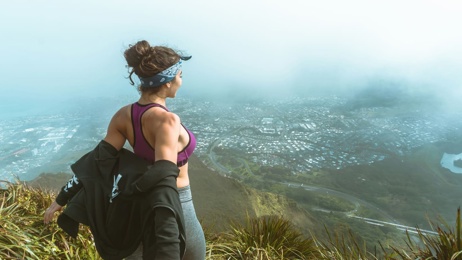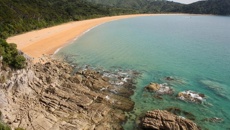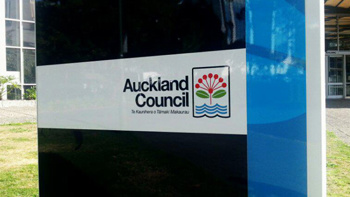
Awakening from a deep sleep following my first day on the Hollyford Track, Pyke Lodge was buzzing with excitement. The day had dawned crisp and clear, and gazing upwards, a mighty giant was flashing its face. Typically shrouded in cloud and mist, the highest peak in Fiordland National Park, Totuku, was fully unmasked, strutting its imposing snow-coated grandeur with the fearless pride of a warrior. Glorious Totuku takes its name from the old Maori chief who the early Europeans encountered.
After a loading up for the day with a splendid breakfast, Justin led our re-energised group on a leisurely amble to stirring Lake Alabaster, wreathed in whiskers of morning mist, to hear the history of the early Maori who lived in the Hollyford from 1650 to the early 1800s. Our wander to the lake took us through thick rainforest, replete with podocarps including manoao, an endangered species of native white pine that’s regenerating in the Hollyford.
The dense rainforest also featured matai, rimu, miro, totara and kahikatea. Justin pointed out the magnificent tree ferns which act like umbrellas in the rainforest, including the mamaku – the world’s biggest tree fern growing 25 metres in height. Lake Alabaster greeted us like a freshly polished mirror, its reflective quality is superlative. The lake was formerly a waka building site, when Maori felled mighty totara from the forest. We learnt about the region’s rich pioneering history.
European gold-prospectors ventured into the valley in 1861, the first being David McKellar and George Gunn. The Hollyford was so named by Patrick Caples, in 1863, after Hollyford in Tipperary. Captain Alabaster, a whaler, sailed around the coast to explore the valley with two gold prospectors, in 1863, and met with the local Ngai Tahu chief, Tutoko. They stayed with the highly hospitable Tutoko and his tribe in Opu, who lent them his canoe to explore Lake McKerrow.
Alabaster showed his gratitude by naming Fiordland’s highest peak in honour of the chief. Tutoko and his tribe left the Hollyford, as the area no longer needed a guardian for the pounamu trails in the area. They relocated to Bruce Bay, further up the coast, where their descendants still live today. We heard how there was consideration given to creating a road from Hollyford to Queenstown by the government in the 1860s, but it was shelved.
The rainforest provided a continuous font of insights, as Justin pointed out some choice specimens including kahikatea, which were ingloriously felled to make butter boxes and clothes pegs. The prized sightings were the rimu, gigantic gods of the forest, some as old as 1200 years old. As a group exercise, it took all 13 if us to hug the full circumference of its trunk! Next up, an intimate encounter with the longest swing-bridge in Fiordland, a staggering steel and wire construction strung across the pristine waters of Pyke River.
On the far side of the bridge, we noticed the sign for the Demon Trail, a gut-busting, thigh-burning 20km-long hilly trail that free-roaming trampers have to contend with to reach Martins Bay. Mercifully, our guided wilderness experience had a far more pleasurable detour via a ripping jetboat ride into Lake McKerrow. We called into ill-fated settlement of Jamestown, where early settlers in the 1870s struggled, toiled and ultimately failed against formidable odds to establish the remote outpost as the new capital of the South Island. From the vestiges of Jamestown we walked our way to Martins Bay, with more sumptuous podocarp rainforest to admire. The increased birdsong was also very conspicuous, like a native avian orchestra.
After feasting on the verdant and vivid forest greenery, the booming surf of the Tasman Sea and windswept sand-dunes served up a startling change in scenery. The Martins Bay area is home to 28 privately owned pieces of land, including the Catholic Church who own the land that Martins Bay Lodge sits on. Ngai Tahu Tourism pay a lease fee to the Vatican. The 28 landowners have done a sterling job in revitalising the natural ecology of the area, raising over $3 million for conservation projects in recent years.
Before reaching the lodge, we strolled up to Long Reef, at the northern tip of the bay, to swoon over the seal colony. Mums and playful pups were lolling about the rocks, while the absentee Dads were apparently in Wellington, where they layabout for 10 months. They only head back to Long Reef for two months to mate. What a life. Sumptuous Martins Bay Lodge is only 7 years old, and is even more pamper-packed than Pyke Lodge. Warmly greeted by Sam and Anna, we started with an antipasto platter, before gorging on blue cod and a chocolate brownie. And the drinks just kept on coming, deep into the night.
After another restorative sleep, the day dawned drizzly as we set off along Martins Bay, eye-balling the surly breakers of the Tasman Sea, to admire two historic sights. We heard about the European settler family, the McKenzies, as we stood around the remains of their homestead, on a mound at the end of the wind-blasted sand spit. From there, a short stroll brought us to the vestiges of the old Ngai Tahu site of Opu, on the beach. Previously used as a summer village, there are numerous middens present across the sand with shellfish and hangi sites.
Justin remarked that Ngai Tahu will occasionally hold a hikoi here, bringing troubled youth to the site to try and engage them with their rich ancestry and set them on a better path. After another ravishing serving of gourmet cuisine for lunch, one final crescendo brought our celestial 3 days to an operatic end. Two choppers landed in front of Martins Bay Lodge, to spirit us to Milford Sound on a riveting, climactic ride, swooping low along the rugged, jagged coastline and purring into the fiord, crowned by Mitre Peak.
Swelling with patriotic pride at this heady serving of scenic exhilaration, our chopper pilot, Chris, completed the aerial theatrics by sticking the snout of his helicopter into the cascading water of Bowen Falls! It’s the best way to wash away the salt-spray from the engine, he wryly remarked - while my heart skipped a beat. What a finale to an epic 3 day wilderness journey, with all the trimmings.
Ngai Tahu Tourism’s Guided Wilderness Walk on the Hollyford Track is a soul-rinsing encounter with Fiordland’s finest features. We traversed Tolkeinesque landscapes, steep-sided glacier-hewn valleys and fiords, snow-capped peaks, mirror lakes, crystal-clear rivers, the soothing tinkle of tiny streams, thunderous waterfalls and seriously remote beaches. You don’t need to be a hard-out tramper to enjoy this experience, a reasonable level of fitness will make this walk very manageable. The guided walk departs every second day from mid-October to late April. www.hollyfordtrack.com
Mike Yardley is our Travel Correspondent on Jack Tame Saturday Mornings.
Take your Radio, Podcasts and Music with you









